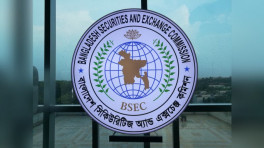DSE lowers tick size to Tk0.01 for shares under Tk1
New tick size to be effective from 29 October

The Dhaka Stock Exchange (DSE) is introducing a new tick size for shares trading below Tk1 in Bangladesh's capital market. The exchange announced that, effective 29 October 2025, the minimum price movement (tick size) for shares trading under Tk1 will be Tk0.01.
Currently, the tick size for all equity securities is Tk0.10. However, with the market prices of some shares recently falling below Tk1, the existing tick size has become incompatible with market conditions. To ensure smoother and more realistic trading, DSE is implementing this new rule.
Experts said this will allow more granular price movements and make price discovery more realistic.
DSE officials said the prices of some small and medium-sized company shares are hovering near Tk1, and already, the shares of two companies have fallen below this level. Under the current Tk0.10 tick size, these shares would not be able to trade under the existing circuit breaker rules, resulting in halted trading.
For example, if a stock's price falls from TK1.00 to Tk0.90, it represents a 10% drop, which is considered a significant movement in the market. Investors would not be able to place orders at prices like Tk0.95 or Tk0.92, causing price determination to stagnate and trading volumes to decline.
In this context, under Regulation 18 of the Dhaka Stock Exchange Automated Trading Regulations, 1999, DSE has decided for the first time that the tick size for shares trading below Tk1 will be Tk0.01.
Tick size refers to the smallest possible price change of a share. For example, with a tick size of Tk0.10, a stock priced at Tk10.00 can move directly to Tk10.10, but not Tk10.05; or it can fall to Tk9.90, but not Tk9.96. Tick size is a fundamental element of market structure, influencing price precision, bid-ask spreads, liquidity, and investor trading strategies.
DSE shareholder director Minhaz Mannan Imon said that they have informed the regulatory authority BSEC about the new tick size for shares trading below Tk1.
He also noted that this is a historic event in DSE's history, as no company's share price had ever fallen below Tk1 before. The situation has now reached a point where the tick size for sub-Tk1 shares must be reconsidered.
Two companies fall below Tk1
Recently, Peoples Leasing and Financial Services Ltd (PLFSL) and Fareast Finance & Investment set a historic record on the DSE, with their shares trading at Tk 0.90 each.
According to DSE data, 104 companies and mutual funds are currently trading below their face value of Tk10. Among them, 70 companies belong to sectors such as banking, insurance, non-bank financial institutions, textiles, food, services, and engineering, while 34 are mutual funds.
Even more concerning, 55 of these companies and funds are trading below Tk5, indicating a serious crisis of investor confidence.
Market insiders said investor confidence in Bangladesh's stock market has dropped sharply. Political uncertainty, economic slowdown, and liquidity crises have severely impacted the market, resulting in continuous declines across sectors, with many shares trading far below their face values.
Analysts note that overall economic challenges, persistent political instability, and investor losses have pushed the market into deep pessimism. Many investors are withdrawing funds due to fears of long-term losses, and new investor participation is nearly zero.
Additionally, a lack of confidence in BSEC, negative sentiment around legal reforms, weak institutional investor participation, and concerns over investment safety have worsened the situation.
Benefits of new tick size
DSE believes that reducing the tick size to Tk0.01 will allow more precise price movements, making price discovery more realistic and market-friendly. Investors will now be able to place orders at exact prices such as Tk0.87, Tk0.88, or Tk0.89, which will: reduce bid–ask spreads, increase liquidity, and lower trading costs.
Market insiders said this change will reduce price stagnation, increase trading, and align the market structure with international standards.
For investors, this is positive, as they can place more precise orders, the order book will deepen, and market participation will rise. Investors holding shares in these companies will now have the opportunity to trade again.
However, brokerage houses will need to update their trading software and systems to accommodate the new tick size.



 Keep updated, follow The Business Standard's Google news channel
Keep updated, follow The Business Standard's Google news channel
















